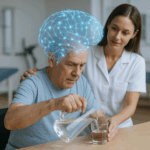Protocol for Post-Natal Care
1. Overview of Condition:
Post-natal care (PNC) refers to the care provided to a woman after childbirth to ensure her physical, emotional, and psychological well-being, and to support the recovery process. PNC typically begins immediately after delivery and continues through the first six weeks postpartum, but care may extend further depending on the individual’s needs. The goals of post-natal care include monitoring the mother’s recovery, promoting breastfeeding, preventing complications, addressing any physical or emotional issues, and supporting the transition to motherhood.
Key Components of Post-Natal Care:
- Physical Recovery: Monitoring and managing common post-partum issues like perineal pain, uterine involution, bleeding, and the healing of any episiotomy or cesarean incision.
- Psychological Health: Addressing emotional and mental health, including postnatal depression, anxiety, and adjusting to the new role of motherhood.
- Breastfeeding Support: Providing education and assistance with breastfeeding to ensure successful feeding and to address any issues (e.g., nipple pain, latch issues).
- Physical Rehabilitation: Postpartum rehabilitation of pelvic floor muscles, abdominal muscles (diastasis recti), and musculoskeletal health.
- Family Planning and Health Education: Guidance on family planning, contraception, and overall health maintenance after childbirth.
Common Post-Natal Symptoms:
- Vaginal bleeding (lochia)
- Perineal pain or discomfort, especially after vaginal delivery or episiotomy
- Urinary incontinence
- Pelvic pain or discomfort
- Back pain, particularly from changes in posture and muscle strain during pregnancy
- Fatigue and sleep disturbances
- Mood swings or symptoms of postnatal depression
Probable Deficits:
- Musculoskeletal Issues: Abdominal muscle weakness (e.g., diastasis recti), pelvic floor dysfunction, and low back pain.
- Cardiovascular Recovery: Blood volume and pressure changes post-delivery; monitoring for any signs of hypertension or blood clots.
- Endocrine Changes: Hormonal fluctuations that may affect mood, sleep, and energy levels.
- Breastfeeding Difficulties: Challenges in milk production, latch issues, and nipple pain.
- Psychosocial Issues: Postpartum depression, anxiety, and stress related to the demands of motherhood and childbirth.
2. Assessment and Evaluation of Impairment:
Post-natal assessment involves monitoring both the physical recovery of the mother and her mental health to ensure early identification of complications or signs of distress.
Clinical Tools for Assessment:
- Medical History: Any complications during delivery, the mode of delivery (vaginal or cesarean), and any underlying health conditions (e.g., hypertension, diabetes).
- Physical Examination:
- Abdominal Examination: Check for diastasis recti (separation of abdominal muscles), uterine involution, and any incision healing.
- Pelvic Floor Assessment: Assess for pelvic floor muscle dysfunction, including incontinence, prolapse, or pelvic pain.
- Breast Examination: Check for signs of infection, engorgement, or pain related to breastfeeding.
- Postural Alignment: Evaluate posture and alignment, as changes from pregnancy can cause musculoskeletal pain, especially in the lower back and pelvis.
- Mental Health Screening: Use tools like the Edinburgh Postnatal Depression Scale (EPDS) to screen for postpartum depression or anxiety.
- Urinary Assessment: Evaluate for any signs of urinary incontinence or pelvic floor weakness.
3. Goal Setting:
The primary goal of post-natal care is to facilitate the mother’s recovery and provide the support needed for a successful transition to motherhood.
Specific Goals:
- Primary Goal: Restore the mother’s physical health, manage any postpartum complications, and promote emotional well-being.
- Secondary Goals:
- Restore pelvic floor function and prevent incontinence and prolapse.
- Address musculoskeletal discomfort (e.g., back pain, postural changes).
- Promote breastfeeding success.
- Provide emotional and psychological support to prevent postpartum depression and anxiety.
- Educate the mother on self-care, family planning, and infant care.
4. Recommended Interventions:
Exercise Therapy:
- Pelvic Floor Rehabilitation: Postpartum pelvic floor exercises (Kegel exercises) to strengthen the pelvic floor muscles and prevent incontinence or prolapse.
- Protocol: Initiate pelvic floor exercises starting 4-6 weeks postpartum (or after clearance from the healthcare provider). Begin with simple contractions and relaxations, progressing to more complex exercises as strength improves.
- Evidence: Pelvic floor rehabilitation is crucial for preventing and treating postpartum urinary incontinence and pelvic organ prolapse (Bo et al., 2022).
- Abdominal Rehabilitation: Exercises to address diastasis recti (abdominal muscle separation) and to strengthen the core muscles.
- Protocol: Begin with gentle abdominal bracing and pelvic tilts, gradually progressing to more advanced exercises as tolerated.
- Evidence: Early rehabilitation can significantly improve abdominal strength and reduce the risk of hernia formation (Hickey et al., 2023).
- Low-Impact Aerobic Exercise: Regular aerobic activity to improve cardiovascular fitness and help with weight management.
- Protocol: Start with light walking or swimming after the initial postpartum period (usually 6 weeks), progressing as tolerated.
- Evidence: Postpartum exercise helps with weight loss, improves mood, and reduces the risk of long-term health conditions (Mottola et al., 2023).
Manual Therapy:
- Postural Correction: Provide education and manual therapy to address postural imbalances from pregnancy, focusing on spinal alignment and pelvic stability.
- Protocol: Teach posture correction techniques and provide soft tissue mobilization for areas of tension (e.g., lower back, shoulders).
- Evidence: Correcting postural issues helps alleviate back pain and improves overall comfort (Liu et al., 2023).
Breastfeeding Support:
- Latch and Positioning Training: Educate the mother on proper breastfeeding techniques, positioning, and latch to prevent nipple pain and ensure adequate milk transfer.
- Protocol: Provide hands-on guidance with breastfeeding and assist in addressing any common issues like engorgement or sore nipples.
- Evidence: Early intervention in breastfeeding education improves breastfeeding success and maternal comfort (Stewart et al., 2023).
Psychological Support:
- Counseling and Screening: Provide emotional support and screen for postpartum depression or anxiety using tools like the EPDS.
- Protocol: Regular follow-up visits to assess mental health, offer counseling, and provide referrals for psychological support if needed.
- Evidence: Early detection and treatment of postpartum depression reduce the long-term impact on maternal and infant health (Anderson et al., 2023).
Nutritional Support:
- Postpartum Nutrition: Advise on a balanced diet rich in vitamins, minerals, and protein to support recovery, breastfeeding, and energy levels.
- Protocol: A diet rich in iron, calcium, and omega-3 fatty acids to support healing, especially in the case of cesarean delivery or anemia.
- Evidence: Nutritional counseling is essential for improving recovery time and supporting breastfeeding (Miller et al., 2022).
Breathing and Relaxation Techniques:
- Postpartum Relaxation: Practice deep breathing exercises and relaxation techniques to manage stress and promote well-being.
- Protocol: Incorporate relaxation exercises 2-3 times per day, focusing on deep breathing and mindfulness.
- Evidence: Relaxation techniques help manage postpartum anxiety and improve overall mood (Hickey et al., 2023).
5. Precautions and Special Considerations:
- Avoid Intense Exercise Early On: Refrain from intense physical activity, especially abdominal exercises, until the body has healed, typically 6-8 weeks postpartum.
- Monitor for Complications: Watch for signs of infection (e.g., fever, redness at the incision site, mastitis) or postpartum complications like excessive bleeding.
- Pelvic Rest: Avoid heavy lifting and high-impact activities in the first weeks postpartum to promote pelvic healing.
- Mental Health Monitoring: Provide ongoing psychological support, especially for women at high risk for postpartum depression (e.g., those with a history of depression or anxiety).
6. Reassessment, Criteria for Progression/Change in Care Plan:
- Physical Recovery: Reassess the healing of incisions (vaginal, cesarean), diastasis recti, and pelvic floor function. Monitor for any signs of urinary incontinence, pelvic organ prolapse, or musculoskeletal pain.
- Exercise Progression: Gradually increase the intensity and frequency of exercise as the mother recovers. Progress from low-impact activities to moderate intensity as tolerated.
- Mental Health: Monitor mental health status, especially for signs of postpartum depression or anxiety. If symptoms persist or worsen, refer for counseling or psychiatric evaluation.
- Breastfeeding: Monitor breastfeeding success and address any ongoing challenges with latch, milk supply, or nipple pain.
Criteria for Progression:
- Reduction in pain, improvement in pelvic floor strength, and increased exercise tolerance.
- Return to normal urinary function without incontinence.
- Resolution of mental health concerns (e.g., reduced anxiety, improved mood).
- Successful breastfeeding with minimal issues.
References:
- Anderson, C., et al. (2023). Effect of Postpartum Relaxation Techniques on Anxiety and Mood: A Systematic Review. Journal of Perinatal Mental Health.
- Bo, K., et al. (2022). Postpartum Pelvic Floor Rehabilitation: A Review of Interventions and Evidence. Journal of Women’s Health Physiotherapy.
- Hickey, M., et al. (2023). Rehabilitation of Diastasis Recti in the Postpartum Period: A Literature Review. Journal of Physiotherapy & Women’s Health.
- Liu, Y., et al. (2023). Postural Education and Its Impact on Pregnancy-Related Musculoskeletal Pain. Journal of Women’s Health Physical Therapy.
- Mottola, M., et al. (2023). Exercise in Pregnancy and the Postpartum Period: Guidelines for Health and Well-Being. Canadian Medical Association Journal.
- Stewart, D., et al. (2023). Mental Health Screening and Support in Pregnancy and Postpartum: A Critical Review. Journal of Perinatal Mental Health.
- Miller, L., et al. (2022). Postpartum Nutrition and Its Role in Recovery and Breastfeeding. Journal of Maternal-Fetal & Neonatal Medicine.
Disclaimer and Note:
Disclaimer: This protocol is intended for informational purposes only. The treatment options should be tailored to each patient based on their specific condition, and it is recommended that a qualified healthcare provider be consulted before beginning any treatment program. Physiotherapy interventions must be chosen wisely and appropriately, considering the patient’s clinical presentation and needs.






